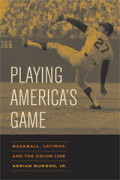


Baseball Toaster was unplugged on February 4, 2009.
Email me at btimmermann@gmail.com
Select a date:
 With the 60th anniversary of Jackie Robinson's debut with the Brooklyn Dodgers being celebrated this year, there has been a lot of discussion about the role of African-American players in baseball. Most of this is about how the numbers have decreased. However, the most prominent minority in baseball now are Latinos, who are some of the game's greatest stars. And yet, their status as a minority is sometimes almost dismissed by American fans.
With the 60th anniversary of Jackie Robinson's debut with the Brooklyn Dodgers being celebrated this year, there has been a lot of discussion about the role of African-American players in baseball. Most of this is about how the numbers have decreased. However, the most prominent minority in baseball now are Latinos, who are some of the game's greatest stars. And yet, their status as a minority is sometimes almost dismissed by American fans.
In his book, Playing America's Game: Baseball, Latinos, and the Color Line, Adrian Burgos, Jr., a University of Illinois assistant professor of history, examines just how Latinos have fit into the sometimes complicated, sometimes arbitrary, and always infuriating, racial picture throughout the sport's history.
Burgos's book might be considered to be a bit on the academic side, more than the popular side, but it still is a good read, especially when the book moves into the history of Latino players in the 20th Century.
The first Latino player to play professional baseball in America was Esteban Bellan, a Cuban who played in the National Association from 1871-73. The second one was Vincent Nava, who was a catcher for Providence of the NL and Baltimore of the AA from 1882-86.
(Note, I helped Burgos with some research on Nava when he was starting research on this book about 7-8 years ago and I'm mentioned in the acknowledgments. I did not receive a free copy of the book, nor did Burgos solicit the review.)
Nava was an interesting case because when he was growing up in San Francisco, he apparently tried to hide his Mexican heritage and went by names like Irwin Sandy or Vincent Irwin, but when he came to the East Coast, he returned to his name of Nava and the Providence team tried to promote his "Spanish" heritage.
Latino players have suffered from the problem of not finding a place to fit in along the color line in the United States. Some Latino players, such as Adolfo Luque and Mike Gonzalez, made it to the majors before Robinson because they were deemed to be white. But Washington catcher Bobby Estalella, was thought to be black by many people, when he broke in with the Washington Senators in 1935.
Then there were the divisions, ones that exist to this day, between African-Americans born in the U.S. and people born in the Caribbean who were also of African descent, such as Martin DiHigo. There were Negro League teams that were almost entirely made up of Cubans and it wasn't until recently that they were recognized by the Baseball Hall of Fame.
After Jackie Robinson broke the color line for African-Americans, the door was open for Cubans, Puerto Ricans, and Venezuelans of color to come into the majors. They ended up fitting into the color line in an unusual spot. The American-born players couldn't speak to them very well and they were usually left alone. However, if teams were playing in the South, sometimes a black Caribbean player would be sent in to order food in restaurants for the whole team because a "foreigner" was treated differently from an African-American.
Burgos also goes on to relate the problems encountered by Orlando Cepeda, whose manager in San Francisco, Alvin Dark, prohibited players from speaking Spanish in the dugout; Roberto Clemente, who faced years of ridicule from the press for his accented English and called "Bob" even though he didn't like the name; to Sammy Sosa, who was beloved at first for his part in the home run chase, and then ridiculed for his poor English, his bat corking incident, and finally, there was a to do in Chicago when a quote of his in English was not "cleaned up" and instead portrayed Sosa in an even worse light. Sosa took an even bigger PR hit after his appearance before Congress when he brought a translator to make his statements during the steroids investigations.
Some people might get a bit bogged down at the beginning of the book, when Burgos is trying to describe America's complex racial politics, but it's necessary for Burgos to make his points later on.
Retired Latino players are looking to be recognized for the sacrifices they made during baseball's integration, but it doesn't seem to be forthcoming. Some news outlets are starting to use more Spanish-speaking reporters to cover the game. But for the near future, Latinos in baseball will just be a big part of baseball, although it will be a group that not many people in America will want to concern themselves with. Latino players paradoxically seem to be both integral to the game of baseball, and yet somehow removed from it in the minds of fans in the U.S.
Comment status: comments have been closed. Baseball Toaster is now out of business.